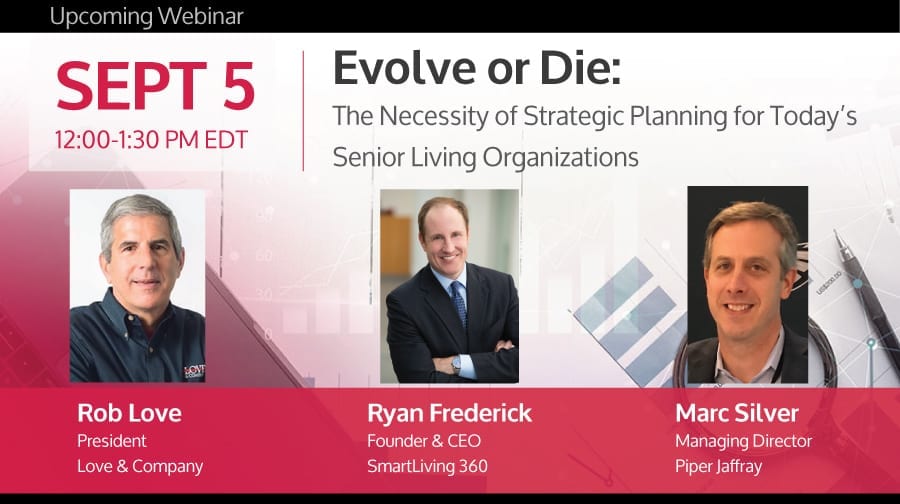Guest blog by Ryan Frederick, Founder and CEO at SmartLiving 360

A strategic plan provides direction, focus and an immediate path for action. In addition, the process of developing a strategic plan aligns a senior living organization’s key stakeholders, including board members, executive leadership and residents, which helps significantly in its execution.
Strategic planning can come in different forms, and depending on your organization, some approaches may work better than others. In this blog, I will focus on two approaches that have been helpful for my clients in the not-for-profit field.
The One-Day Planning Session
For organizations who have never drafted a strategic plan, are less skilled in strategic planning or have a dated plan, a one-day planning session helps to raise awareness and start to address key questions facing the organization. In my experience, these sessions prompt board members and leadership teams to question core assumptions about the field and their existing business. It helps open everyone’s eyes to threats and opportunities in new and energizing ways. It can also be a good steppingstone to a more involved strategic planning process if that is the best path for the organization to pursue.
Who’s invited? Invite all board members and senior leaders to the planning session. It’s also valuable to hear from residents in your communities; however, this approach requires a strong commitment to confidentiality. Ideally, your strategic planning team should consist of no more than dozen or so people.
These sessions can be internally handled, but there are advantages to having an objective third-party advisor manage the day. The best advisor and facilitator is skilled at managing a discussion, directing the dialogue with a bias toward action and wrapping up the dialogue with clear next steps. It’s also wise to have an advisor with deep senior living expertise to provide guide rails for the discussion. Moreover, using a third-party advisor provides a measure of accountability. The opportunity cost of spending a day in an unproductive way is enormous.
What’s on the agenda? The one-day strategic planning session is not a typical board meeting, and it’s not a time to discuss budgets. Rather, the focus of the agenda should be on what’s happening outside the organization with some time dedicated to an honest look within the organization. Some questions include:
- What shifts are happening in the senior living landscape at large, and how are these changes impacting our market?
- What are current challenges or unique opportunities facing our organization?
- What is our unique value proposition today, and what can it be tomorrow?
It is critical that the agenda is carefully crafted to tackle the most pressing strategic questions facing the organization.
How do you prepare? Board members and the leadership team must get their heads in the strategic planning game. To do this, the CEO or chairman of the board should distribute a packet of reading materials and homework before the meeting. Some ideas of what to include in the packet are:
- Articles on changes in the senior living field, the world at large and the evolving nature of strategic planning
- Analyses, case studies and comparisons of other industries and how they adapt (or don’t) to change
- SWOT brainstorming tool used to understand your organization’s strengths, weaknesses, opportunities and threats. The SWOT template should be completed before the strategic planning meeting, although it’s helpful to conduct the exercise as a group.
Although a one-day planning session is a great way to kick off a strategic planning discussion, it won’t lead to an actionable strategic plan; however, it will give your team a starting point for better understanding how your current business aligns with today’s and tomorrow’s likely market realities.
The Process to Develop a Comprehensive Plan
To become a more agile and ambidextrous organization requires a paradigm shift, and this is where a rigorous strategic planning process comes into play. A comprehensive strategic plan is a result of a thorough and diligent process and may take up to six months or longer to develop.
You may ask, “Why such a lengthy process?” Think of the comprehensive plan as a journey where leaders can “live” in the questions raised throughout the strategic planning process—meaning that they may have to struggle with these questions for some time and bring additional information and perspective to refine their position.
Furthermore, developing a strategic plan in today’s climate requires a dynamic process that may not necessarily have a clear beginning and end. For not-for-profit organizations who want to be competitive, innovative—and ideally disruptive—there must be a constant calibration and balance between optimizing for today and placing strategic bets on the future. Succeeding at this balance is the essence of being ambidextrous: solving for today and tomorrow simultaneously.
Preparing for the Plan
Similar to the one-day planning session, participants should include board members, senior leadership and a resident or two. Think quality—not quantity—as this team should have no more than a dozen or so people throughout the entire process. And as mentioned earlier, there is wisdom in working with a third-party advisor. In fact, a third-party advisor is more critical for developing a comprehensive plan than a one-day planning session. Board members and leadership teams often have full schedules and don’t have the capacity to manage a multi-month process. Perhaps just as important, contracting with an advisor creates a clear accountable party for the process. The importance of fit and intellectual capability of this advisor cannot be understated.
Preparation for the comprehensive planning process is not only necessary—it’s mandatory. I recommend that my clients prepare the following materials:
- Articles on changes in the senior living field, in our world in general and strategic planning
- Analysis and comparisons of other industries and how they adapt (or don’t) to change
- SWOT brainstorming tool used to understand your organization’s strengths, weaknesses, opportunities and threats. The SWOT template should be completed before the strategic planning meeting.
- An overview of current demographic and competitive conditions and trends in your primary market area
- Detailed analyses of current operations and business performance
- Internal reports on successes and challenges of current programs
GPS for Senior Living
Fundamental to the growth, opportunity and evolution of the senior living field is rethinking strategic planning. With my clients, I use a three-step process following the metaphor of the global positioning system or GPS. In this exercise, we delve into the following questions:
- Where are we? In this space, I spend time building consensus on where your organization is currently positioned. For example: How do you perceive competition? What’s your unique value proposition? What are the trends of your existing residents and future residents? Where is the field of senior living in its evolution? This includes an evaluation of:
- Mission and values
- Organizational competencies
- Adherence to mission
- “Devil’s advocate” considerations
- Financial assessment
- Broader risk analysis
- SWOT analysis
- Where should we consider going? Here, market data come into focus. How does your market data align with your mission and your financial viability to create a mix of compelling strategic opportunities? This includes consideration of:
- Key constraints
- Magnitude of opportunity
- Design thinking practices
- Blue ocean strategy methods
- Adherence to mission
- Broader risk analysis
- Proformas with scenario analysis
- How do we get there? Strategic plans risk dying without sufficient follow-up. In this section, we develop an implementation plan designed to create alignment, drive accountability, track progress and enhance the likelihood of success.
What strategic planning approach is right for you?
With strategic planning, one size does not fit all, and in the webinar, I’ll discuss factors to help you decide the right fit for your organization. Here are a few key considerations:
- How much time and resources are you devoting to strategic planning? Is this enough for today’s environment?
- What’s your budget for strategic planning?
- In what situations should you lean toward the shorter version?
- In what situations should you opt for the comprehensive approach?
- When might a combination of the two approaches be the best path?
Whether a short or comprehensive approach, the time to prepare for tomorrow is today. By using the right approach for your organization, you can create and own a strategic plan that unleashes potential for the future.
Love & Company invites you to our 2019 Leading Edge C-Suite Webinar Series. It’s not too late to join your colleagues for insights from industry leaders. Register now for the strategic planning webinar on September 5.
—
Read the rest of our Strategic Planning Blog Series:
- Part One, “The Case for Strategic Planning” by Ryan Frederick of SmartLiving360
- Part Two, “Preparing to Plan” by Rob Love
- Part Three, “Financial Positioning for Strategic Growth” by Marc Silver of Piper Jaffray





